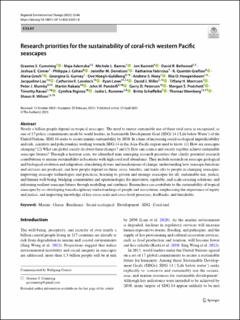Research priorities for the sustainability of coral-rich western Pacific seascapes
| dc.contributor.author | Cumming, Graeme S. | |
| dc.contributor.author | Adamska, Maja | |
| dc.contributor.author | Barnes, Michele L. | |
| dc.contributor.author | Barnett, Jon | |
| dc.contributor.author | Bellwood, David R. | |
| dc.contributor.author | Cinner, Joshua E. | |
| dc.contributor.author | Cohen, Philippa J. | |
| dc.contributor.author | Donelson, Jennifer M. | |
| dc.contributor.author | Fabricius, Katharina | |
| dc.contributor.author | Grafton, R. Quentin | |
| dc.contributor.author | Grech, Alana | |
| dc.contributor.author | Gurney, Georgina G. | |
| dc.contributor.author | Hoegh-Guldberg, Ove | |
| dc.contributor.author | Hoey, Andrew S. | |
| dc.contributor.author | Hoogenboom, Mia O. | |
| dc.contributor.author | Lau, Jacqueline | |
| dc.contributor.author | Lovelock, Catherine E. | |
| dc.contributor.author | Lowe, Ryan | |
| dc.contributor.author | Miller, David J. | |
| dc.contributor.author | Morrison, Tiffany H. | |
| dc.contributor.author | Mumby, Peter J. | |
| dc.contributor.author | Nakata, Martin | |
| dc.contributor.author | Pandolfi, John M. | |
| dc.contributor.author | Peterson, Garry D. | |
| dc.contributor.author | Pratchett, Morgan S. | |
| dc.contributor.author | Ravasi, Timothy | |
| dc.contributor.author | Riginos, Cynthia | |
| dc.contributor.author | Rummer, Jodie L. | |
| dc.contributor.author | Schaffelke, Britta | |
| dc.contributor.author | Wernberg, Thomas | |
| dc.contributor.author | Wilson, Shaun K. | |
| dc.date.accessioned | 2024-01-10T09:17:39Z | |
| dc.date.available | 2024-01-10T09:17:39Z | |
| dc.date.created | 2023-06-14T09:58:37Z | |
| dc.date.issued | 2023 | |
| dc.identifier.citation | Regional Environmental Change. 2023, 23 (2), . | |
| dc.identifier.issn | 1436-3798 | |
| dc.identifier.uri | https://hdl.handle.net/11250/3110792 | |
| dc.description.abstract | Nearly a billion people depend on tropical seascapes. The need to ensure sustainable use of these vital areas is recognised, as one of 17 policy commitments made by world leaders, in Sustainable Development Goal (SDG) 14 (‘Life below Water’) of the United Nations. SDG 14 seeks to secure marine sustainability by 2030. In a time of increasing social-ecological unpredictability and risk, scientists and policymakers working towards SDG 14 in the Asia–Pacific region need to know: (1) How are seascapes changing? (2) What can global society do about these changes? and (3) How can science and society together achieve sustainable seascape futures? Through a horizon scan, we identified nine emerging research priorities that clarify potential research contributions to marine sustainability in locations with high coral reef abundance. They include research on seascape geological and biological evolution and adaptation; elucidating drivers and mechanisms of change; understanding how seascape functions and services are produced, and how people depend on them; costs, benefits, and trade-offs to people in changing seascapes; improving seascape technologies and practices; learning to govern and manage seascapes for all; sustainable use, justice, and human well-being; bridging communities and epistemologies for innovative, equitable, and scale-crossing solutions; and informing resilient seascape futures through modelling and synthesis. Researchers can contribute to the sustainability of tropical seascapes by co-developing transdisciplinary understandings of people and ecosystems, emphasising the importance of equity and justice, and improving knowledge of key cross-scale and cross-level processes, feedbacks, and thresholds. | |
| dc.language.iso | eng | |
| dc.title | Research priorities for the sustainability of coral-rich western Pacific seascapes | |
| dc.title.alternative | Research priorities for the sustainability of coral-rich western Pacific seascapes | |
| dc.type | Peer reviewed | |
| dc.type | Journal article | |
| dc.description.version | publishedVersion | |
| dc.source.pagenumber | 15 | |
| dc.source.volume | 23 | |
| dc.source.journal | Regional Environmental Change | |
| dc.source.issue | 2 | |
| dc.identifier.doi | 10.1007/s10113-023-02051-0 | |
| dc.identifier.cristin | 2154341 | |
| cristin.ispublished | true | |
| cristin.fulltext | original | |
| cristin.qualitycode | 1 |
Files in this item
This item appears in the following Collection(s)
-
Articles [3009]
-
Publikasjoner fra CRIStin [3056]
